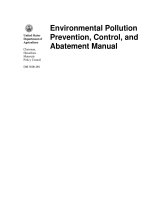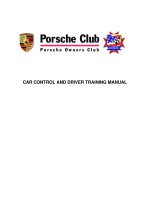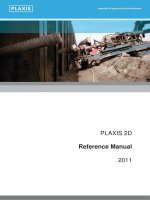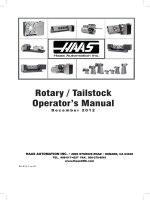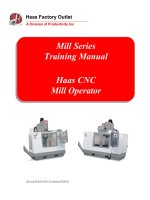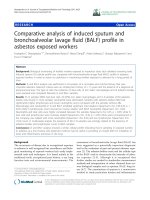AUTOMOTIVE WORKER ASBESTOS TRAINING MANUAL potx
Bạn đang xem bản rút gọn của tài liệu. Xem và tải ngay bản đầy đủ của tài liệu tại đây (486.97 KB, 50 trang )
AUTOMOTIVE WORKER ASBESTOS TRAINING MANUAL
2
THIS PAGE LEFT INTENTIONALY BLANK
3
Automotive Worker Outline
Asbestos Basics
I. Characteristics
1. Naturally - occurring mineral fiber, locations
2. Heat and chemical resistant
3. High tensile strength - breaks into very small fibers
II. History of Asbestos Usage
1. Early uses - Greeks, Charlemagne
2. Late 19th century "rediscovery"
3. Commercial uses of asbestos
4. Concerns over asbestos usage
III. Toxicity and Hazard
1. Toxic - definition
2. Hazard - definition
IV. Hazard Assessment
1. Types of Asbestos - chrysotile, amosite, crocidolite
2. Definition of
A
sbestos
C
ontaining
M
aterial
3. Identification of asbestos - sampling, laboratory ID
4. Asbestos Containing Materials found in automotive work - brakes, clutches,
gaskets, etc.
4
Health Effects of Asbestos
I. Asbestos as a Health Hazard
1. Introduction
2. Factors affecting risk of developing a disease
a. Properties of asbestos
b. Howasbestosentersthebody
c. Concentration and duration of exposure
d. Critical dose
e. Individual Susceptibility
f. Group Susceptibility
g. Smoking and asbestos exposure
II. How asbestos enters the body
1. Respiratory system
2. Digestive system
3. Fiber migration
III. Body Defenses
1. Nose Hairs
2. Mucociliary Escalator
3. Phagocytes - white blood cells
IV. Non - Harmful Signs of Asbestos exposure
1. Pleural plaques
2. Asbestos bodies
3. Asbestos warts
4. Pleural thickening
5. Pleural effusion
V. Asbestos Related Diseases
1. Asbestosis
a. Definition
b. Risk
c. Latency
d. Symptoms
e. Diagnosis
2. Lung Cancer
a. Definition
b. Risk
c. Latency
d. Symptoms
e. Diagnosis
5
3. Mesothelioma
a. Definition
b. Risk
c. Latency
d. Symptoms
e. Diagnosis
4. Digestive System Cancers
Asbestos Medical Monitoring
I. Establishing a medical monitoring program
II. Purpose of a medical monitoring program
1. Establish fitness to wear a respirator
2. Screening for asbestos related diseases
3. Not for full diagnosis or treatment
4. Not to take the place of regular checkups
III. Content of a medical monitoring program
1. Medical and work history questionnaire
2. Physical exam
3. Pulmonary function test/chest X-ray
IV. The State Employees Medical Monitoring Program
1. Location
2. Scheduling of exams
3. Frequency of exams
4. Who must attend
5. Medical records
Safety Issues
I. Heat Stress
1. Heat Cramps
2. Heat Exhaustion
3. Heat Stroke
4. Prevention
II. Carbon Monoxide
1. Sources
2. Exposure Limits
3. Symptoms of Poisoning
4. Prevention
6
Regulatory Review
I. OSHA - Occupational Safety & Health Administration
MOSH - Maryland Occupational Safety & Health
1. The General Industry Standard for Asbestos - 29 CFR 1910.1001
a. Focus on workplace Safety & Health
b. Sets P.E.L. (permissible exposure limit) at 0.1f/cc
1. Requires engineering controls
2. Requires work practice controls
3. Requires worker protection
c. Sets Short Term Exposure Limit at 1f/cc in 30 mins.
2. The General Industry Standard for Respiratory Protection - 29 CFR 1910.134
a. Focus on written respiratory protection programs
b. Has 11 specific requirements
3. The General Industry Standard for Access to Employee Exposure and Medical
Records - 29 CFR1910.1020
4. The General Industry Standard for Hazard Communication - 29CFR
1910.1200
II. The Environmental Protection Agency
1. The Asbestos Manufacturing, Processing, Importation, and Distribution
Prohibitions
II. COMAR - Code of Maryland Regulations
1. Labor & Employment Article Title 5. Occupational Safety & Health Subtitle 4
-Access to Information on Hazardous & Toxic Substances
a. Sets requirements for
C
hemical
I
nformation
L
ists
IV. The Maryland State Employees Asbestos Program - Executive Order 01.01.1987.22
1. Established in 1983, revised in 1987
2. Provides incentive pay for asbestos work
3. Requires
1
/
2
faced negative pressure respirators or PAPR's and protective
clothing to be used by automotive workers doing asbestos work
4. Requires employees to be clean shaven where the respirator seals to the face.
5. Established refusal/consent provisions for asbestos work
6. Established safe work practices for automotive work
7
Personal Protective Equipment
I. Personal Protection
A. Protective Clothing
1. Purpose
2. Requirements
3. Options
4. Who must wear
5. Donning and Removal
B. Respiratory Protection
1. Purpose
2. Types
3. Selection
4. Inspection
5. Cleaning
6. Storage
7. Repair and Replacement of Parts
8. Donning and Removal
9. Fit Testing
10. Factors Affecting the Fit
11. Protection Factors
C. Powered Air Purifying Respirators
1. Description
2. Filters
3. Batteries
4. Breathing Hose
5. Face Piece
6. Flow Testing
D.
1
/
2
Faced Negative Pressure Respirator
1. Description
2. Filters
3. Face piece
8
Work Practice Review: Automotive Brake & Clutch Work
CONTROL METHODS: 3 Principles To Be Emphasized
(1) Prepare Work Area,
(2) Minimize Fiber Release, &
(3) Proper Cleaning & Disposal
AREA PREPARATION
Access Limited; (3 foot rule)
Signs Posted;
Appropriate Barriers Erected or Asbestos Component Enclosed;
Equipment Available to Prevent Fiber Release During Job, e.g., HEPA Vacuum and
Enclosure Device OR Approved Wet Collection Device;
6 Mil Plastic and Duct-Tape Available to Cover Floor;
Appropriate Respirator and Disposable Clothing Available;
Cleanup Supplies;
6 Mil Labeled Disposal Bags for Friable Asbestos Waste;
Appropriate Containers for Non-Friable Asbestos Waste;
MINIMIZE FIBER RELEASE
Smoke Tubes or Other Procedures to Verify Effectiveness of Containment System
Use of Appropriate Control Device
Prohibition of Grinding
Prohibition of Use of Compressed Air Stream outside of vacuum enclosure
Prohibition of Other Procedures That Are Likely to Generate Airborne Asbestos Fiber
Release
CLEANUP AND WASTE DISPOSAL
Means to Decontaminate Brake Shoes, Clutch Plates, and Other Equipment Available;
Means to Decontaminate Friable Asbestos Waste Containers Before Removal from
Regulated Area;
Procedures to Account for and Track Asbestos Waste Both Friable and Non-Friable;
Procedure to Verify Completion of Cleanup
9
LEARNING OBJECTIVES FOR LEVEL II TRAINING: AUTOMOTIVE
I.
ORIENTATION
A.
Background
Following this presentation employees will be able to:
1. Identify the source of asbestos (naturally occurring mineral).
2. Define asbestos containing material (1% or greater). This is an
EPA/OSHA definition. The State Program says that any material
containing any amount of asbestos is an asbestos containing material.
3. Know that the only positive means of asbestos identification is
laboratory analysis.
4. Identify common sources of exposure and locations of asbestos in State
Automotive Facilities.
5. Be able to determine who is a Level II employee and what asbestos
related work is permitted to be done by State Employees.
6. Define the term friable.
7. Recognize when asbestos materials pose a potential health problem.
8. Be aware of notification procedures in the event an asbestos hazard is
suspected.
9. Know the requirements for carrying out asbestos related work in State
Facilities.
B.
Objectives for Legal Aspects
1. Employees should recognize the OSHA PEL and excursion limit for
asbestos and the limitations of this regulation in disease prevention.
2. Be familiar with automotive work requirements as outlined in OSHA's
29CFR 1910.1001 standard section (f)(3) and Appendix F.
3. Be familiar with the requirements of 29 CFR 1910.134 for respiratory
protection and workplace monitoring.
10
4. Be able to cite the common uses for asbestos and which ones are still
allowed by the EPA
5. Know the requirements for asbestos disposal in Maryland.
C.
Medical Aspects
Following this presentation workers will
1. Recognize the most common diseases associated with asbestos
exposure.
2. Identify the most common route of entry for asbestos into the body.
3. Recognize the Dose (Exposure) - Response Relationship between
inhalation of asbestos dust and disease development.
4. Know the 3 defensive mechanisms the body has against asbestos
exposure.
5. Know the meaning of latency and how it applies to asbestos related
disease.
6. Know the symptoms, prognosis and treatment for asbestos related
diseases.
7. Recognize the importance of personal protection and dust control
measures in preventing asbestos related diseases.
8. Be aware of the relationship between cigarette smoking and asbestos
related lung cancer.
9. Be aware of the potential danger of contaminating work clothes with
asbestos.
10. Identify 3 methods of reducing the risk of asbestos related disease in
the workplace.
11. Be aware of the medical confidentiality provisions of the State
Employees Asbestos Program.
12. Understand the limitations of a medical surveillance program.
13. Recognize the symptoms of heat related disorders and carbon
monoxide poisoning and preventative measures that reduce the risk of
developing these problems.
11
II.
Control of Asbestos Hazards
The worker is expected to demonstrate his knowledge and understanding of the
content of this training by:
- correctly answering at least 18 of 25 questions on the written test given at the
end of the class, and
- implementing principles and practices of asbestos hazard control on the job.
(This is subject to verification by review and inspection by the instructor).
In turn, demonstrable success in the above will indicate achievement of the training
and re-training objectives of the Maryland State Employees Asbestos Program
A.
Control Methods:
Following this presentation the trainees
1. are expected to state when asbestos may be hazardous, and
2. list the four essential control methods (prepare area, protect worker,
minimize fibers, cleanup and disposal. Workers shall be encouraged to
take those four principles and apply them to individual work
situations).
B.
Personal Protection:
Following the training on protective clothing and respiratory protection, the
trainees are expected to be able to:
1. State the reason for wearing protective clothing, the kind and items of
protective clothing required to be worn, and when it is to be worn.
2. Describe and/or demonstrate the recommended donning, taping, and
removal procedures.
3. Describe and/or demonstrate proper cleaning procedures before
disposable protective clothing is removed, with emphasis on leaving
the respirator on until clothing has been disposed of.
4. State the essential function of a respirator.
5. List criteria used as a basis for selecting proper respiratory protection.
12
6. Describe characteristics of and differentiate between air-purifying and
air-supplied respirators.
7. Describe how a positive-pressure respirator differs from a negative-
pressure respirator, and state how a positive pressure respirator
provides greater protection against asbestos exposure.
8. State the limitations of ½ faced negative pressure and PAPR respirators
in oxygen-deficient atmospheres.
9. Describe inspection, maintenance, cleaning, and storage procedures the
worker (user) is expected to perform.
10. Describe procedures to be done bytheSafetyandHealthSpecialist,
rather than the user (repair and replacement of parts).
11. Describe and/or demonstrate proper respirator donning and removal
techniques.
12. Describe the purpose and various procedures of fit testing a respirator,
state factors affecting fit as well as State policies applicable.
13. Describe the concept of "protection factors" and relate that to the
respirator types selected for the asbestos program.
14. Describe and/or demonstrate a working understanding of a half-face
piece dual cartridge respirator (including positive and negative fit
testing).
15. Describe and/or demonstrate a working understanding of a powered air
purifying respirator (PAPR), including the HEPA filters, NiCad
batteries (and the use of a flowmeter to flow test the PAPR.
C.
Preparation of the Work Area:
Upon completion of this portion of the training, the workers are expected to be
able to:
1. List required and recommended procedures, including removal of
unnecessary personnel from the immediate area: removal of non-
essential tools, furniture, or other movable objects (to avoid
contamination).
2. Describe and/or demonstrate procedures for laying 6 mil poly drop
sheet on floors, constructing poly barriers to isolate brake/clutch work
if feasible.
13
3. Describe and/or demonstrate methods of enclosing the work itself, such
as a vacuum enclosure system for automotive brake work, etc.
4. Describe the requirements for restricting access to the work area,
posting of signs.
D.
Minimizing Release of Asbestos Fibers into the Air
Upon completion of this portion of the training, workers are expected to be
able to:
1. Describe and/or demonstrate the use of fiber-containment devices such
as a vacuum enclosure system, wet collection system, and plastic
enclosures to confine fibers and restrict contamination of adjacent
areas.
2. State the reasons for using the alternate "wet methods: and describe
appropriate procedures for doing this.
3. Describe and/or demonstrate the design, proper use, and maintenance
of the HEPA Vacuum for asbestos-related work, and the limitations of
conventional "shop-vac" for such work.
E.
Cleanup and Disposal of Asbestos Waste:
Upon completion of this presentation, workers will be able to:
1. Describe two recommended methods of cleanup following asbestos
work.
2. List steps, in order, in which cleanup is to be done and state reasons for
doing it in that manner.
3. Describe approved methods for disposal of asbestos waste,
contaminated clothing and materials. These include double-bagging
and sealing in 6 mil poly bags, clearly labeled as to contents and
breathing hazard; us of locking-top fiber drums, and transport to a
landfill that will accept asbestos waste.
14
ASBESTOS SUBSTITUTE MATERIAL
USES OF ASBESTOS
PRODUCT CONTAINING ASBESTOS SUBSTITUTE MATERIALS
Friction Products Clutch Facings, Disc Brake Pads, Brake Semi-metallic Disc Pads,
Drums for Cars, Trucks, Trailers, Metal Non-Asbestos Clutch
Facings
Cement Pipe Asbestos-Cement Pipe Metal Pipes - Ductile Iron; Plastic Pipes - thermosetting
resin pipe (RPM); Polyvinyl chloride pipe (PFV); Pre-
tensioned Concrete-Metal Pipes (PT).
Cement Sheet Asbestos-Cement Sheet, Drywall Glass Fiber Rein-forced cement Sheet, Laminated
Hardboard, (Benelex) Board, Cement/Wood Board,
Calcium Silicate Cement Sheet, Polypropylene Cement
Sheet, Alumina Sheet, Dual walled metal sheets inter
layered with mineral wool, Mineral Fiber Cement Sheet.
Refractory Cement Refractory Asbestos Cement Aluminum Silicate Cement, Calcium Silicate Cement,
Mineral Fiber Cement, Wollastonite Fiber Cement,
Fiberglass Cement.
Roofing Products Roofing Felts, Roofing Paper, shingles Fiberglass Felts, Single Ply Systems -
polymeric system
ethylene propylene diene monomer
butyl neoprene
polyvinyl chloride
chlorinated,
polyethylene sulfonated
(CPE), - Modified bitumens;
Organic felts
Thermal Insulation Asbestos Pulp (loose asbestos fibers) Compound (Approximate Maximum Use Temperature)
Polyurethane Foam (257
o
F) sealed, Polystyrene Foam
(150
o
F) sealed, Urea Formaldehyde Foam 150
o
F) sealed,
Cork (700
o
F) Aramid, Flax Fibers (190
o
F), Ceramic
Fibers - Aluminum Silicate Fibers (2200
o
F), Calcium
(1500
o
F), Silica Fibers (1500
o
F), Mineral Wool
(1200
o
F), Rock Wood (1200
o
F), Sintered Powdered
Metal (700
o
F), Franklin Fibers (Calcium Sulfate)
(1800
o
F, Aluminum Borosilicate Fibers (600
o
F), Steel
Fibers (1000
o
F), Fiberglass (1300
o
F).
Pipe Wrapping Insulation Asbestos Textile, Asbestos woven Fiberglass Textile and
into cloth tape, rope, braids, Papers, Silicate Fiber
sleeving, blankets, Asbestos Paper. Textiles and Papers, RocWool, Mineral Wool, Ceramic
Textile and Papers, Aluminum Silicate Textiles and
papers, Calcium Silicate Textiles and Papers,
Polyurethane Foam, Glass Form, Polystyrene Form, Urea
Formaldehyde Foam.
15
Protective Clothing Asbestos Textile, Asbestos woven Fiberglass Textiles, Cotton
into cloth blankets, or mats. Entwined Fabric, Aramid Fabric, Stabilized
Polyacrylonitrile Fabric, Novaloid Phenolic Fabric, High
Temperature Nylon Fabric, Modacrylic Fabric, Heat
Resistant Leather.
Electrical Insulation Asbestos Textile, Asbestos woven Mica, Ceramic Textiles -
into cloth,rope, braids, and yarn. Aluminum Silicate Textiles, Calcium Silicate Textiles,
Rubberized Wire Coatings.
Gaskets Asbestos Gaskets, Asbestos embedded Vegetable Fiber Sheet, Cork,
in high temperature rubber. Teflon (PTFE), Expanded Teflon, Rubber (high
temperature), Graphite.
Additive Plastics (Phenolic, vinyl, epoxy, Mica, Clay Talc, Clay,
unsaturated polyester, urea, diallyl Wollastonite, Processed
phthalate, poly propylens Mineral Fiber (PMW),
thermosetting polyester). Fiberglass,Franklin
Coatings (Paints, caulk, sealants) Fibers, Ceramic Fibers,
Textile Fibers (aromatic
Filters polyamide), Mineral Fibers.
Fiberglass, Textile Fibers, Ceramic
Fibers, Mineral Cellulose, Fiberglass,
CeramiFibers, Rock Wool, Textile Fibers, Polyvinyl
Chloride (PVC).
Compression Packings Asbestos Textile, Asbestos woven into Aramid Yarn, Graphite/
yarn tape, or braids Teflon-Composite, Teflon
(PTFE), Graphite Tape,
Flax Yarn, Ceramic Textile.
CAUTION: SUBSTITUTE MATERIALS
USE THE SAME PRECAUTIONS AS FOR ASBESTOS TO ELIMINATE THE INHALATION OF FIBROUS SUBSTITUTE MATERIALS: KEEP THE
DUST DOWN; USE VENTILATION WHERE POSSIBLE; USE RESPIRATORS.
16
HOW HOT IS YOUR JOB?
During hot summer months the excess heat at work can be more than uncomfortable - it can be
dangerous. Excess heat and humidity can decrease alertness, cause fatigue and slow reactions,
leading to a greater chance of accidents.
HOW HEAT AFFECTS YOU
Under moderate conditions the body automatically adjusts itself to keep its temperature within
safe limits. Sweating is the body's most efficient means of getting rid of heat, but the more
humid the air, the harder it is for sweat to evaporate and the harder it is for the body to cool off.
Under hot and humid conditions, work becomes harder because much of our blood is going to
the surface of the body, and less is available to the active muscles. Loss of salt from sweating
can result in fatigue.
Health Dangers
FAINTING. Workers who stand still for long periods of time while working in a hot place may
black out.
HEAT FATIGUE. Psychological strain from heat exposure can result in irritability, drowsiness
and less coordination.
HEAT CRAMPS. Cramps in the leg and arm muscles and in the stomach may result when a
person drinks but doesn't take in enough salt.
HEAT EXHAUSTION. Losing too much fluid, salt or both will result in heat exhaustion.
Heavy sweating, weakness, nausea and headache results and skin is moist and pale. In serious
cases vomiting and lose of consciousness may occur.
HEAT STROKE. When the body is unable to sweat and can't get rid of excess heat, heat stroke
may result. The skin becomes hot, dry and spotted red. The temperature of the body rises,
sometimes as high as 106
o
F. Confusion, delirium and convulsions and death may result.
HOW TO MEASURE HEAT
A regular thermometer can't tell you if it's too hot to work safely. You need to know more than
the air temperature. The important factors for measuring heat are:
Air temperature
Humidity
Air movement
Heat coming off hot surfaces
17
A special thermometer called the Wet Bulb Globe Thermometer combines all four factors into a
single reading, which is called the Wet Bulb Globe Temperature (WBGT). When this reading
reaches 79
o
F. (WBGT) health illnesses can develop.
HOW TO REDUCE HEAT STRESS
Cool drinking water should be available.
Local ventilation can draw hear or steam from the work area.
Hot equipment should be isolated, enclosed or insulated.
Operating heat of equipment can be set to minimum temperatures.
Frequent breaks and air conditioned or cooler rest areas are necessary.
Heavy work can be scheduled in the coolest part of the day.
OSHA requires employers to provide you with a safe and healthful work environment.
18
CARBON MONOXIDE
Carbon monoxide (CO) is an odorless, colorless and tasteless gas which gives no warning to its
victim. It is the most widespread gas hazard in industry today and has taken the lives of
Maryland workers. Carbon monoxide is usually produced by the incomplete burning of fossil
fuels. A common source of carbon monoxide is the internal combustion engine.
Carbon monoxide's main effect is to rob the body of its oxygen supply. After being inhaled, CO
combines 200 times faster with the blood's oxygen carrier, hemoglobin, than does oxygen. This
means that a worker can die of carbon monoxide poisoning even when there is plenty of oxygen
available in the air.
Carbon monoxide must also be considered a safety hazard. The unsuspecting worker may be
affected by drowsiness or poor coordination likely sources of accidents. The potential for CO
poisoning is greater in the winter, when ventilation is usually decrease in factories, warehouses
and
garages
due to the closing of doors and windows.
WHAT ARE THE SYMPTOMS?
An exposure to carbon monoxide may be sudden with symptoms coming on rapidly. It is
important to know these symptoms. They may be the only warning a worker has that carbon
monoxide is in the area. Headache and dizziness may be followed by a ringing in the ears,
nausea, muscle weakness, breathlessness or confusion. Continued exposure may cause a loss of
consciousness and eventually death.
Since many of these symptoms may be mistaken for common ailments (such as the flu), it is
important to take note of symptoms seen in groups of workers. Is several workers in one area
complain of headache and dizziness, consider carbon monoxide as the possible cause.
WHO IS AFFECTED?
All workers are potentially at risk. There are no body defenses against carbon monoxide
poisoning. Be sure all work is performed with adequate ventilation to help minimize the risk of
CO exposure. Carbon monoxide can be generated by many operations, processes or equipment,
some of which include:
Arc Welding
Automobile Use & Repair
Bakeries
Blast Furnaces
Brass Foundries
Breweries
Brick Manufacture
Coke Ovens
Compressed Air Operations
Cupola Operations in Iron and Steel Foundries
19
Iron Working
Kiln Firing (indoors)
Laundries
Lift Trucks (Gasoline & Propane)
Metal Oxide Reduction
Organic Chemical Manufacture
Space Heaters
Tunnel Operations
Warehousing Operations
THE POTENTIAL FOR EXPOSURE BECOMES MUCH GREATER ANYTIME WORK
IS BEING DONE IN AN ENCLOSED AREA.
PREVENTION
Elimination
- The best approach, whenever possible, is to eliminate the cause of carbon
monoxide at its source. Some warehouses, for instance, have switched from gasoline or propane
powered forklifts to electric powered forklifts.
Ventilation
-Properventilationisoftenthemosteffective means to prevent overexposure to CO.
Local exhaust ventilation which captures the gas at its source is usually preferred. In auto shops,
a local venting duct should be attached to the tailpipe of any running automobile.
Maintenance
- Fuel burning devices engines, stoves, furnaces, heaters - should be inspected
regularly and adjusted for maximum combustion efficiency. Deficient units should be repaired
(or replaced) promptly to make sure that the least possible amount of CO is being generated.
Monitoring
- Employers and workers should survey a workplace to determine which processes
are likely to generate CO. Inexpensive sampling equipment is available which can determine the
presence of CO and also estimate the amount of CO present in the air.
Alarms
- If there is a danger of CO leaking into a workplace, audible or visible alarms or signals
should be used to protect workers.
Emergency Plan
- In areas where the possibility of a large CO exposure exists (such as a leak
from a pipeline), an emergency plan should be developed. Training must be provided for
workers so that they know about the plan and what to do in an emergency. The plan should
cover correct rescue equipment (including SCBA respirators), oxygen availability and medical
response. MOSH can review emergency plans and provide advice about their effectiveness.
20
First Aid Treatment
If a worker is found unconscious, do not automatically assume it is a heart attack. Consider CO
poisoning, and take immediate steps to protect yourself and others who may be exposed.
If you suspect CO poisoning, move
the victim at once to an uncontaminated area. Tragic
accidents have occurred where people have tried to rescue or give first aid to a co-worker in a
poisonous atmosphere.
Once you are in the fresh air, begin CPR, if necessary, while someone calls for emergency
medical care. Be sure to tell the medical personnel that CO poisoning is suspected.
TheRoleofMOSH
For Workers
- MOSH enforces the carbon monoxide standard and will respond to worker
complaints. Any employer found overexposing workers to carbon monoxide could receive a
citation requiring corrective action. In addition, MOSH will provide training to groups of
workers on the hazards of carbon monoxide. Speakers are available as well as a slide/tape
presentation on the topic.
For Employers
- MOSH's Consultation services program is available to employers upon request.
An industrial hygienist will monitor the workplace to determine if there is a potential carbon
monoxide hazard and provide written recommendations for preventing worker exposure to CO.
There is no charge for this service.
21
ASBESTOS MEDICAL MONITORING PROGRAM FOR STATE EMPLOYEES
INTRODUCTION
The State of Maryland is concerned with safe guarding the occupational safety & health of its
employees. It was this concern that prompted the signing by the Governor of an Executive Order
putting the State Employees Asbestos Program into effect.
The prevention of work related illness and accidents depends on awareness of risk, control of the
work environment and the promotion of healthful & safe work practices. The State Employees
Asbestos Program is working towards providing a safer work environment be providing
mandatory training to all employees who may be potentially exposed to asbestos in the
performance of normal work activities. Any employee whose job activity may require cutting
into, breaking, or otherwise disturbing asbestos or asbestos containing materials has been
designated as a Level II employee and is required to participate in the Medical Monitoring
Program.
WHAT IS MEDICAL MONITORING
Medical monitoring is a screening of the health of Level II and former Level II employees by
means of periodic medical examinations. The purpose of medical monitoring is to both detect
and prevent possible adverse health effects of occupational exposure to asbestos dust as early as
possible and to evaluate an employee's fitness to wear a respirator. For State employees in Level
II job categories that have duties that may involve potential asbestos exposure, medical
monitoring can provide the following.
. Early recognition of pre-existing lung disease or other conditions that may affect an
employee's ability to wear a respirator or work with asbestos.
. Prompt referral for follow-up of abnormal findings.
. Indication of the effectiveness of respirator use & safe work practices taken to reduce
asbestos exposure. (By looking at the rate of asbestos related diseases among Level II
employees since the program began).
. Identification of health factors that may increase an individual's risk of developing
asbestos related disease.
. Determination of appropriate follow-up and counseling for early asbestos related
conditions or smoking.
. Periodic evaluation of fitness for respirator use and work with asbestos.
22
The examination provided is highly specific for the detection of asbestos related illness or
respiratory abnormalities. The purpose of this examination is not to take the place of your
regular physical exams or routine medical care.
WHO IS ELIGIBLE FOR MONITORING?
The Medical Monitoring Program provides medical examinations for all Level II State
employees whose work may involve exposure to asbestos. Under the provisions of the State
Employees Asbestos Program it is mandatory that any employee who works with asbestos must
participate in medical screening. The exam will be offered to all Level II employees, including
retired employees and new employees prior to placement.
If an employee can document previous Level II exposure as a State employee but who no longer
works with asbestos, he or she may also participate in the Medical Monitoring Program.
If an employee refuses to work with asbestos, he or she will not be eligible for medical
monitoring unless previous Level II exposure to asbestos as a State employee can be
documented.
CONTENT OF THE EXAMS:
The exams will consist of:
. Questions about medical & work history
. Measurement of the blood pressure
. Examination of the heart & lungs
.Chestx-ray
. Pulmonary function test (to evaluate lung function)
CONFIDENTIALITY:
Confidentiality of medical records will be assured with access limited strictly to medical
personnel. Records will be subject to release pursuant to the Federal (OSHA) Regulation of
Access to Employee Exposure and Medical Records 29CFR1910.1020. Supervisory personnel
will only receive information that workers have been examined & approved for respirator use.
Employees that want a copy of their medical records must request the Medical Release
Authorization form and fill it out. The form can be obtained from The State Employees
Asbestos Program.
RESULTS OF THE EXAMS:
Employees will be individually notified of their fitness for duty. Information will be sent
directly to the employee’s home address from the clinic. Recommendations will be made for
follow-up screening and referral if appropriate.
23
SIGNIFICANCE OF ABNORMAL TEST RESULTS:
Many of the abnormalities found in people who work with asbestos may also be found in the
general population, and may or may not be a result of exposure to asbestos on the job. Questions
concerning abnormal test results should be discussed with the Medical Monitoring Physician at
the clinic.
ANNUAL FOLLOW-UP EXAMS:
Employees will return for follow-up exams annually.
FOR FURTHER INFORMATION ABOUT MEDICAL MONITORING. YOU MAY
CONTACT THE STATE EMPOLYEES ASBESTOS PROGRAM.
24
LAWS AND REGULATIONS
The law is one tool for a safer and healthier job. However, the protection furnished by
occupational and environmental safety laws depend extensively on how well people comply with
these provisions. When it comes to asbestos and other hazardous materials, substantial
compliance is not enough. Everyone must do their part. For example, if just one individual fails
to comply with the requirements, he/she could create conditions that endanger the entire work
crew or could contaminate the environment. Thus, it is extremely important for everyone
working with asbestos to know the safety and health requirements. Each person must follow
them to the letter and should insist that fellow workers also follow the requirements.
Supervisors have a ethical and legal responsibility to ensure that work proceeds in a safe
manner. The minimum standards for safe asbestos work are prescribed in regulations set forth
by OSHA (the Occupational Safety and Health Administration) and EPA (the Environmental
Protection Agency). These regulations were promulgated on statutes enacted by Congress, and
carry enforcement penalties for non-compliance. There are also State of Maryland Regulations
based on laws enacted by the Maryland General Assembly, which both complement and
supplement Federal Regulations.
As stated before, these regulations set the minimum requirements to protect workers and
the environment from asbestos hazards. Before any work commences on an asbestos job, you
should assess all the potential safety & health hazards on the job site, and be sure that appropriate
control measures are implemented according to established practices in the industry. It is
recommended that a copy of the OSHA regulation 29 CFR1910.1001 and its Appendix F be
checked as part of the project planning process.
25
ASBESTOS STANDARDS and REGULATIONS
Occupational Safety and Health (OSHA)
General Industry Standards
29 CFR 1910.1001
ASBESTOS
Replaced 1910.1001 Asbestos, tremolite, anthophyllite, and actinolite on August 10, 1994.
Adopted by Maryland (MOSH) on Jan. 31, 1995.
Applies to all occupational exposure to asbestos except
work in construction and in ship
building, repairing, and breaking (have their own specific standard).
Permissible Exposure Limits of 0.1 fibers per cubic centimeter of air as an 8-hour Time-
Weighted Average (TWA) exposure and as an Excursion Limit (EL) of 1.0 f/cc of air
averaged over a 30-minute sampling period.
Specific compliance methods for brake and clutch repair and service:
Engineering controls and work practices for brake and clutch inspection,
disassembly, repair, and assembly operations:
must use a negative pressure enclosure/HEPA vacuum system (Method A) or
a low pressure/wet cleaning method (Method B) as detailed in Appendix F.
may use an equivalent method if it demonstrates results similar to Method A in
Appendix F.
Exception
:
if no more than 5 pair of brakes or clutches per week are inspected,
disassembled, repaired, or assembled, the method in paragraph (D) of
Appendix F may be used.
